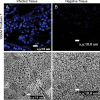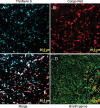New features of invasive candidiasis in humans: amyloid formation by fungi and deposition of serum amyloid P component by the host
- PMID: 22802434
- PMCID: PMC3570177
- DOI: 10.1093/infdis/jis464
New features of invasive candidiasis in humans: amyloid formation by fungi and deposition of serum amyloid P component by the host
Abstract
Background: Invasive candidiasis occurs in the gastrointestinal tract, especially in neutropenic patients. We were interested in determining whether invasive fungi formed amyloid in humans as they are known to do in vitro. We also sought to characterize the consequence(s) of such amyloid formation.
Methods: Tissue from 25 autopsy patients with invasive candidiasis of the gastrointestinal tract was stained with amyloidophilic dyes and for the presence of serum amyloid P component (SAP). Confirmation of the interaction of SAP and Candida was demonstrated using Candida albicans and mutants for amyloid formation.
Results: Amyloid was present on the cellular surface of fungi invading gut tissue. Moreover, SAP bound to the fungal cell walls, confirming the presence of amyloid. In vitro observations showed SAP bound avidly to fungi when amyloid formed in fungal cell walls. An unexpected result was the lack of host neutrophils in response to the invading fungi, not only in neutropenic patients but also in patients with normal or increased white blood counts.
Conclusions: We report the first demonstration of functional fungal amyloid in human tissue and the binding of SAP to invading fungi. It is postulated that fungal amyloid, SAP, or a complex of the proteins may inhibit the neutrophil response.
Figures




Comment in
-
Invasive candidiasis: new insights presaging new therapeutic approaches?J Infect Dis. 2012 Nov;206(9):1339-41. doi: 10.1093/infdis/jis521. Epub 2012 Aug 22. J Infect Dis. 2012. PMID: 22927458 No abstract available.
References
-
- Olsen A, Jonsson A, Normark S. Fibronectin binding mediated by a novel class of surface organelles on Eschereichia coli. Nature. 1989;338:652–5. - PubMed
MeSH terms
Substances
Grants and funding
LinkOut - more resources
Full Text Sources
Other Literature Sources
Miscellaneous

